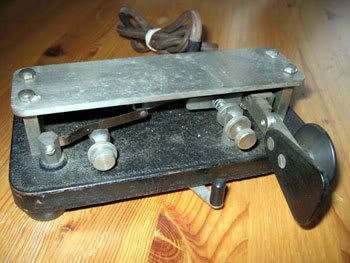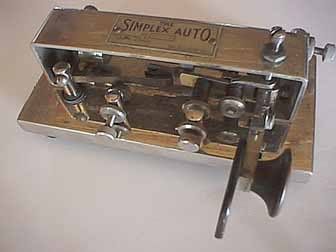I was cruising my usual web sites looking to see what was new among key collectors when a photo reminded me of my own semi-automatic enigma.
The key shown at right arrived at my shack several months ago. It was part of a 3-key deal, and probably the best of the bunch — at least the most unique of the three.

It has no markings on it, and the seller assumed it was a homebrewed key. I don't believe it is because of the quality of the construction. It doesn't look homebrewed, though someone could have assembled it themselves.
The key bears a strong resemblance to two keys that were built and sold in Australia.
The first is shown below at right, it is the BMR Codemaster right-angle bug. This key is similar but very different in some respects.
The second Aussie key it resembles is the bottom photo of the three, the Simplex Auto right-angle bug.
All three of these keys use a similar system to make dots. Rather than use a system similar to the Vibroplex vibrating lever set in motion by the key lever hitting its stop, these keys release tension on the vibrating arm.
When the keying lever is at rest, the vibrating arm is pushed against a stop, which preloads its main spring with an adjustable amount of tension. When the lever is pushed to the right to make dits, the vibrating arm is released, allowing it to vibrate to create Morse code dits.
This system on some U.S. keys was used to avoid infringing on the Vibroplex patents. I don't know if that was a factor on the design of the Aussie keys or not.

My key has several differences in how it is designed from the Codemaster or the Simplex Auto.
1. There is no cover over the mechanism. On the Simplex Auto, the cover supports the upper pivot movement. On the Codemaster, it does not.
2. The key base is exactly as wide as the keying arm is long. There is not extra space as is found on the other two right-angle bugs.
3. All three keys share the same type of dot contact mechanism — a contact mounted on a length of spring steel, mounted so it has some “give,” for the same reason Vibrplex dot contacts are mounted on the U-shaped leaf spring.
4. Each dot contact spring has a adjustment to give the user a way to vary the distance between the keying lever contact and the dot contact. But note on the Codemaster and the Simplex, this adjustment bumper is located roughtly midway between the mounting post for the dot contact spring and the contact itself. On my right-angle bug, the adjustment bumper is right at the contact point where the key lever and the dot contact meet.
This is an important difference, and possibly points to what I believe was a mistake in the design of the key I own. Here's why.
On my key, adjusting the dot contact screw can quickly deaden the action of the key. I've struggled with trying to find an adjustment point that would allow for reasonably close spacing and not kill the action of the key at the same time — which it invariably does.

I'm sure that placing the adjustment point in the middle of the leaf spring allows for adjusting the gap without killing the spring action. I'm going to see if I can try to create an adjustment point that simulates the Codemaster and Simplex Auto and see how the key operates.
Right now, the best I can get from the key are very choppy, very very short dits. Horribly short dits. And due to the adjustment screw dampening the keying lever, it only will give you 5 or 6 dits before it stops. I could live with that, but after the 3rd dit, the rate of the dits slows considerably. Sending the letter H or number 5 wouldn't sound very pretty, or be very pleasant for someone to copy.
It doesn't matter if its adjusted for fast or slow code, the dits are still too choppy for my taste. Changing the adjustment point may make a difference.
But will I actually alter the key to change the adjustment point? That's a tough question. Probably not. I would like to find a way to rig the key to operate in an improved manner, so I'll have to experiment. I don't think I want to alter the key permanently, but I would like to make it operable. I don't like having a key around that I can't put on the air.
I'm off to my laboratory for experimentation (insert Boris Karloff-like chilling glare).
73 de KY4Z … dit dit
